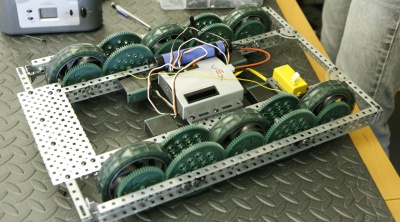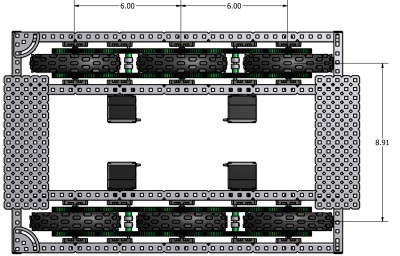Difference between revisions of "6wd"
MaiKangWei (talk | contribs) |
MaiKangWei (talk | contribs) |
||
| Line 12: | Line 12: | ||
6wd should not provide more traction than 4wd (again, all other things being equal - robot weight, drive power per side, gearing, wheel base, wheel friction coefficients). This premise is based on calculation and was not tested. | 6wd should not provide more traction than 4wd (again, all other things being equal - robot weight, drive power per side, gearing, wheel base, wheel friction coefficients). This premise is based on calculation and was not tested. | ||
| + | |||
| + | Sacrifices associated with the change from 4wd to 6wd are: | ||
| + | * Increase weight | ||
| + | * Increased complexity | ||
| + | * 6wd imposes design constraints | ||
| + | |||
| + | |||
---- | ---- | ||
| − | [[Category:Robot]] | + | [[Category:Robot]][[2008 Drive-train Development]] |
Revision as of 14:55, 14 June 2009
6-Wheel-Drive Tank drive-trains are one of the more popular and successful drive-trains employed by FRC robots. Team 1640 learned why during our 2008 summer drive-train prototyping and testing.
A ½-scale 6wd prototype was desiged and built using Vex parts. Dimensions are shown at left. Based on our Twitch experience, we would have expected this prototype to be difficult to steer. It was not. This discovery led us to embark on a careful analysis of drive-train behavior.
A detailed analysis can be seen in the Microsoft Powerpoint Team 1640 Drive-train Lesson.
The key conclusion is that in changing from 4wd to 6wd Tank drive (and keeping all else constant), the frictional resistance to turning is significantly reduced. This occurs even when the middle wheels are kept on the same plane as the front and rear (many teams lower the middle wheels relative to the other). The key benefit of 6wd versus 4wd is therefore improved steering capability and greater available turning torque.
A secondary benefit would be in avoidance of bottoming out when climbing ramps.
6wd should not provide more traction than 4wd (again, all other things being equal - robot weight, drive power per side, gearing, wheel base, wheel friction coefficients). This premise is based on calculation and was not tested.
Sacrifices associated with the change from 4wd to 6wd are:
- Increase weight
- Increased complexity
- 6wd imposes design constraints
2008 Drive-train Development

